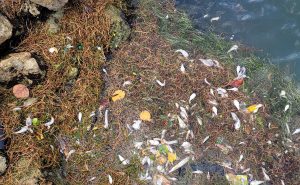Update: Tuesday, October 25, 2022
In about one weeks’ time, the North Biscayne Bay fish kill event is now over. The collective response efforts of the multiple organizations listed below in the original post revealed the consistently higher dissolved oxygen (DO) levels throughout North Bay, indicating that DO levels have returned to a more normal range.
At Pelican Harbor Marina, DO levels increased substantially: at the surface: 8.2 mg/L, at the bottom: 6.8 mg/L. These are values suited to supporting marine life.
Following the 2020 fish kill event, Miami-Dade County’s Division of Environmental Resource Management created a rapid response plan. One of the key elements of this plan was procuring a contractor that could visit the most highly affected sites to remove dead carcasses. This component of the plan was activated immediately last week, a critical step in preventing the decomposition of the carcasses, which could fuel an algal bloom, similar to what happened in 2020.
The exact cause of this fish kill event remains unknown. Pinpointing the specific cause is logistically difficult, if not impossible, as there are so many non-point sources of pollution into North Bay. These include large rain events, coastal construction, nutrient inputs, stormwater runoff, sewage leaks, and managed water bodies such as the two canals in close proximity to North Bay. Management agencies are continuing to study the data collected as well as monitor to look for warning signs that could indicate a future fish kill.
Please continue to keep eyes on the water and report anything unusual. Citizen reports are key to detecting these types of events. You can email me at azangroniz@ufl.edu, or file a report with Miami Waterkeeper.
Original post: Friday, October 21, 2022
Just over two years ago, Biscayne Bay experienced a prolonged fish kill event in August of 2020. Since then, things have been relatively calm with a few isolated fish kill events. Just two days ago, on Wednesday, October 19, reports came in of fish kill observations yet again. Now, on day three, it has been estimated that several hundred fish have been floating at the surface as well as gasping for breath in several sections of North Bay-the same region where the 2020 fish kill took place. This is considered by Miami-Dade County to be a “major” fish kill: more than 1,000 fish dead. Affected species include pufferfish, toadfish, mullet, pinfish, barracuda, mangrove snapper, nurse sharks, and more.

The 2020 fish kill was driven by low dissolved oxygen (DO) resulting from a combination of many factors, and the 2022 event seems to be following a similar trend. Low DO readings were found at Pelican Harbor Marina today, with values higher at the surface than at the bottom. Let us put this into context. Good dissolved oxygen levels stand around 7-8 millgrams per liter (mg/L). Today’s values at Pelican Harbor Marina showed .07 mg/L at the bottom, and .22 mg/L at the surface. No matter how you look at it, those are almost anoxic (no oxygen) conditions. This explains why the fish are at the surface, appearing to gasp for air. Unfortunately, these organisms will not likely survive, as they are biologically meant to be breathing oxygen from under the surface of the water…by the time we see them at the surface, it’s too late and their fate is inevitable.

Several agencies and organizations are responding to this event, including but not limited to: Miami-Dade County RER, Florida Department of Environmental Protection Biscayne Bay Aquatic Preserves, Florida International University, University of Miami, Miami Waterkeeper and others. It may be challenging to pinpoint the exact cause of this fish kill event, but we can rule out elevated sea surface temperature (warmer water=less available DO, and the water is much cooler now than it was in August of 2020). Since Hurricane Ian passed through the state three weeks, ago, it is possible that the influx of freshwater through our managed canal system may have influenced this event.

In any case, it is critical to continue employing best practices when it comes to minimizing human inputs into the Bay. These include continuing to refrain from applying fertilizers to your home landscape through the duration of the rainy season, October 31 (per Miami-Dade County ordinance), keeping lawn or yard clippings out of waterways, storm drains and sewers, limiting use of nitrogen application by getting your soil tested, and making sure not to pour any chemicals, paints, or commercial oils down your home drain.
Please stay tuned for updates as we continue monitoring the situation. If you observe any water quality anomalies or more distressed wildlife in the bay, please report to pollution@miamiwaterkeeper.org or file a report.
 2
2
